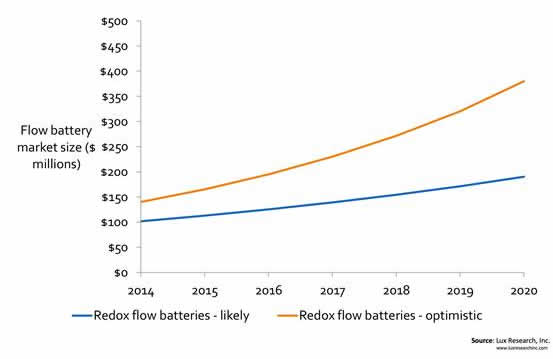Large-scale stationary energy is key to a smarter power grid
According to Lux Research: large-scale stationary energy is key to a smarter power grid and for integration of intermittent renewables; Redox flow batteries are touted as an emerging option, but have been too expensive; and now, falling costs will carve out a 360MWh market in 2020, worth $190m.
Within the stationary energy storage market, four flow battery chemistries, led by vanadium-based systems, are gaining commercial traction. The Vanadium Redox Flow Battery (VRFB) is the most mature technology and accounts for 75MWh of deployed systems.
“VRFBs will remain the dominant system for the medium-term but bromine-based systems are cheaper and will eventually be better-performing on a 10-year horizon,” said Dean Frankel, Lux Research Associate and the lead author of the report titled 'Flow Battery Cost Reduction: Exploring Strategies to Improve Market Adoption'.

Flow batteries will command a $190m market opportunity by 2024, in the likely case
“However, flow batteries will remain limited to longer-duration applications, and are competing directly with fast-moving targets in Li-ion and other next-generation storage technologies,” added Frankel.
Lux Research analysts evaluated factors driving cost reduction in flow batteries, and market strategies. Among their findings:
- ZnBr is cheapest but questions remain. In Lux Research’s model, VRFBs are the most expensive flow battery chemistry, costing $516/kWh in 2024. Zinc bromine (ZnBr) will be the cheapest flow battery at $391/kWh in the same year, but questions remain surrounding their lifetime and operating costs.
- Improving power density is key. Flow batteries suffer from relatively poor power density, and improving this metric will drive down costs. Improvements in cell stack power density, for example, can cut VRFB system costs by 33%.
- Lowering vanadium input costs will not be a panacea. VRFB developers are claiming that sourcing vanadium from fly ash will reduce costs from over $500/kWh today to $300/kWh at scale. However, Lux finds that even in the unrealistic scenario of a free vanadium electrolyte, VRFB system costs will be $324/kWh in 2024.





